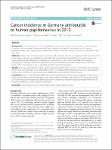Cancer incidence in Germany attributable to human papillomavirus in 2013
Buttmann-Schweiger, Nina
Deleré, Yvonne
Klug, Stefanie J.
Kraywinkel, Klaus
Background: It is estimated that a total of 120,000 new cancer cases in men and in women in more developed countries could be avoided if exposure to HPV was prevented. We used the nationwide pool of German population-based cancer registry data to estimate the burden of HPV-attributable cancer in this population for the year 2013. Methods: Incident cases of cervical cancer, squamous cell carcinoma of the anus, oropharynx (OP), as well as of the vulva, vagina and penis were classified as potentially HPV-associated and identified from the nationwide cancer registry data-pool. We calculated the incidence and proportions of cancer with potentially HPV-associated morphologies. Estimation of the HPV-attributable incidence was based on prevalence-estimates of viral DNA in tumor cells in the respective sites, as provided from the international literature. Results: From the overall 15,936 incident cases of anogenital and OP cancers in 2013, 6239 female and 1358 male cancer cases were estimated to be attributable to HPV. The majority of HPV-attributable cases were contributed by cervical cancer (70.9% of female cancers) and oropharyngeal cancer (46.9% of male cancers). Conclusions: Even if most HPV-attributable cases were contributed by cervical cancer, anogenital cancer at sites other than the cervix, and oropharyngeal cancer substantially contribute to the burden of HPV-associated cancer. Our nationwide cancer registry data-analyses provide the baseline for long-term population-based monitoring of vaccination-effects on cancer incidence in Germany.
No license information

